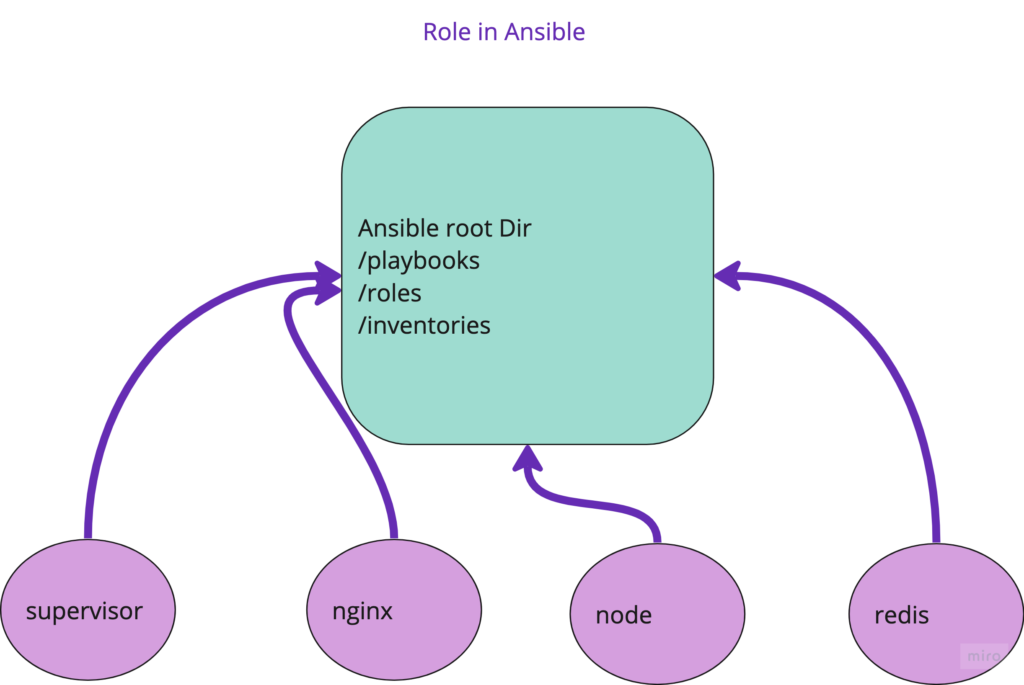What is a role in ansible?
Role in Ansible serves as organized units encapsulating related tasks, handlers, variables, files, templates, default values, dependencies (defined in the meta directory), and test cases. A role comprises sub-folders within the designated role folder, each containing a main.yml file to encapsulate its specific content. This structuring simplifies the management of intricate task sets, similar to how objects in programming encapsulate functionalities for reuse.

Roles significantly enhance playbook readability and maintainability by providing a modular and reusable structure. Assembling related functionalities into a single role, it promotes cleaner code, easier debugging, and facilitates code reuse across multiple projects. Just as functions in programming abstract complex logic, roles encapsulate Ansible configurations, allowing for streamlined execution across various environments. This modular approach fosters better organization, readability, and efficiency within Ansible playbooks, contributing to smoother automation workflows.

Prerequisite
Install Ansible
It will install ansible-playbook, ansible-galaxy, and other ansible commands as well.
On Mac, brew update; brew install ansible.For other platforms refer to https://docs.ansible.com/ansible/latest/installation_guide/intro_installation.html
Learn more about ansible setup
Create base setup
Let us understand this by creating a role and understanding its folder structure. We will first set up the root directory.
create ansible dir
mkdir ~/ansible
go inside this directory
cd ansible
Create playbooks and roles folder
mkdir playbooks roles
Create inventory.yml with the below contents
# inventory.yml
---
all:
children:
webservers:
hosts:
webserver-01:
Now, let us create a role named role1 by executing
go inside roles directory
cd roles
create a role role1
ansible-galaxy role init role1
A new role created using the above command has the below directory structure
role1
├── README.md
├── defaults
│ └── main.yml
├── files
├── handlers
│ └── main.yml
├── meta
│ └── main.yml
├── tasks
│ └── main.yml
├── templates
├── tests
│ ├── inventory
│ └── test.yml
└── vars
└── main.yml

Now we can add our contents in main.yml or create new files as per our requirements. We should also delete unused folders and files.
Let us learn it further by automating sudo apt update command
Add below task in roles/role1/tasks/main.yml
- name: Update apt cache
apt:
update_cache: yes
Create a sample webservers playbook (webservers.yml)
cd playbooks
touch webservers.yml
and add the below contents
—
# webservers.yml
- name: Setup webserver
hosts: webservers
become: yes
roles:
- ../roles/role1
Execute webservers.yml as below
cd playbooks && ansible-playbook webservers.yml -i inventory.yml
Reusing roles in another role or task
We can reuse a role in a task file or within a task file of a given role by using include_role.
Let us understand this by setting up a git repo on our target servers.
Setup git role
First create a git role
cd roles && ansible-galaxy create role git
Add below contents in roles/git/tasks.yml
- name: Install git
apt:
name:
- git
state: latest
update_cache: yes
- name: Clone repo - {{repo}}
git:
repo: '{{repo}}'
dest: '{{dest}}'
version: '{{version}}'
force: yes
become_user: '{{user}}'
Setup up service role
Create a role named service
cd roles && ansible-galaxy create role service
Add below contents in roles/service/tasks/main.yml
- name: Setup Repo - repo1
include_role:
name: ../roles/git
vars:
dest: 'repo1'
version: 'release'
repo: repo1
- name: Setup Repo - repo2
include_role:
name: ../roles/git
vars:
dest: 'repo2'
version: 'release'
repo: repo2
Execute webservers.yml as below
cd playbooks && ansible-playbook webservers.yml -i inventory.yml
Benefits of using roles in Ansible
- Simplifies complex playbook and task organization.
- Increases modularity
- Task reuse by using include_role in Ansible
- Readability

Conclusion
Role in Ansible is a pivotal organizational tool, streamlining playbook management by encapsulating related tasks, handlers, variables, and dependencies into modular units. They emulate the concept of objects in programming by bundling functionalities for reuse and clarity. The hierarchical structure they establish simplifies the orchestration of complex tasks, promoting a more systematic and maintainable approach to infrastructure automation.
Role in Ansible offers a multitude of benefits, such as enhancing readability, promoting reusability, and facilitating collaboration among team members. By compartmentalizing tasks into distinct roles, they foster code modularity and scalability, enabling easier maintenance and debugging. Moreover, roles encourage best practices by enforcing a standardized layout for playbooks, promoting consistency across projects and teams.
Ultimately, leveraging roles in Ansible empowers DevOps teams to efficiently manage configurations, enforce consistent deployments, and foster a more organized and scalable automation framework, leading to smoother and more reliable infrastructure management.
Reference: https://docs.ansible.com/ansible/latest/playbook_guide/playbooks_reuse_roles.html
4 thoughts on “Role In Ansible Demystified: A Simple and Master Guide in 4 Easy Steps”